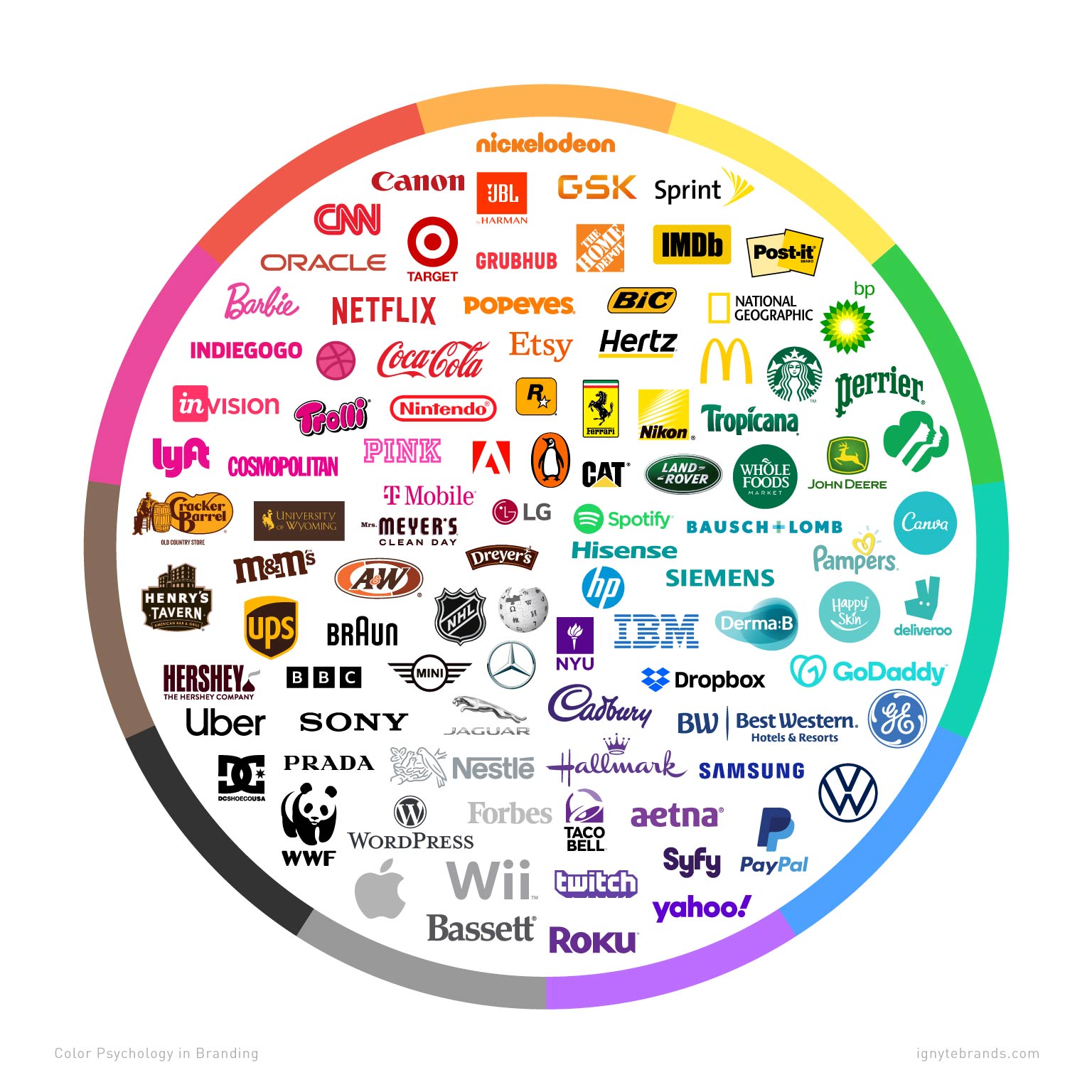
Have you ever stopped to think about why certain fast food logos are red and yellow? Or why hospitals often use calming shades of blue and green? The answer lies in the magical world of color psychology, where hues have the power to influence our emotions, behaviors, and even our buying decisions. So grab your color wheel and buckle up, because we’re about to dive headfirst into the wild and wacky world of logo design and the powerful role that colors play in shaping our perceptions. Let’s paint the town red, blue, and every shade in between!
The Role of Color in Brand Recognition
Color plays a crucial role in brand recognition. In fact, choosing the right color can make or break a brand’s identity. Imagine if McDonald’s golden arches were suddenly painted purple – it just wouldn’t have the same effect, would it?
When it comes to color choices, brands need to be strategic. They need to consider the emotions that different colors evoke in consumers. For example, red is often associated with passion and excitement, while blue conveys trust and reliability. So, if you want your brand to be seen as adventurous and daring, you might want to consider incorporating some fiery reds into your logo.
But it’s not just about picking a color and sticking with it. Consistency is key. Your brand’s color palette should be used across all marketing materials, from your website to your social media posts. That way, consumers will begin to associate those colors with your brand, making it easier for them to recognize you in a crowded marketplace.
So, the next time you’re debating between shades of green or blue for your brand, remember the power of color in brand recognition. Choose wisely, and watch as your brand stands out from the rest!

Choosing the Right Color Palette for Your Logo
So you’re ready to create a logo for your brand, eh? Well, buckle up because choosing the right color palette is no walk in the park! It’s like trying to pick out the perfect outfit for a first date – you want to make a good impression, but you also want to show off your personality. Here are a few tips to help you nail that logo color palette:
First things first, consider the psychology behind colors. You want to evoke the right emotions in your audience, so choose wisely! Here’s a quick breakdown:
- Red: Excitement, passion, danger
- Blue: Trust, peace, stability
- Yellow: Optimism, warmth, caution (because you don’t want your logo looking like a traffic light)
Next, think about your target audience. Are they sophisticated urbanites or outdoorsy adventurers? Your color palette should speak to them on a personal level. Remember, you’re not just choosing colors – you’re crafting a visual identity that resonates with your customers.
Lastly, don’t be afraid to get a little wild with your color choices. Mixing unexpected hues can make your logo stand out from the crowd. Just make sure they play well together, like a well-choreographed dance party. So go forth, brave designer, and paint your logo with all the colors of the wind! Or, you know, just pick a couple that look nice together. Your call.

How Color Influences Customer Perception
Color psychology is a powerful tool for businesses looking to influence customer perception. Think about it – have you ever walked into a store and immediately felt happier because of the bright, cheerful colors on the walls? Or have you ever been turned off by a brand because their logo was an unattractive shade of brown? Color plays a much bigger role in our purchasing decisions than we realize!
The first thing customers notice when they walk into a store or view a website is the color scheme. It sets the tone for their entire interaction with the brand. Here are some ways that color influences customer perception:
- Red: This color invokes passion and energy. It’s often used to create a sense of urgency and excitement, which is why it’s commonly used for sales and promotions.
- Blue: Blue is a calming color that instills trust and reliability. It’s often used by businesses that want to convey a sense of professionalism and stability.
- Yellow: Yellow is associated with happiness and optimism. It’s a great choice for brands that want to appear cheery and approachable.
Next time you’re rebranding or redecorating your store, don’t underestimate the power of color! It could be the difference between customers walking in with a smile or walking out empty-handed. Choose your colors wisely, and watch your customer perception soar!

Utilizing Color Psychology to Evoke Emotions
Color psychology is not just some hokey-pokey pseudoscience; oh no, it’s a powerful tool that can evoke emotions and influence behavior. It’s like the Jedi mind trick of the design world – use it wisely, you must!
Let’s break it down, shall we? Here’s a crash course in how different colors can make you and your audience feel:
- Red: Feeling fiery and passionate? Red is your go-to hue. Just watch out for those angry bull vibes it can also bring out!
- Blue: Feeling calm and collected? Dive into the soothing abyss of blue, my friend. It’s like a serene ocean for your soul.
- Yellow: Feeling sunny and optimistic? Yellow is like a burst of sunshine in your designs. Just be careful not to blind anyone with your radiance!
- Green: Feeling fresh and rejuvenated? Green is the color of nature and growth. It’s like a cleansing breath of air for your visuals.
So next time you’re designing something, remember to think about the emotions you want to evoke and choose your colors wisely. After all, who knew that something as simple as a color wheel could have such Jedi mind tricks up its sleeve?

Creating a Memorable Brand Identity through Color
Choosing the right colors for your brand can make a huge impact on how memorable and recognizable it is. Think about it – would Coca-Cola be as iconic if it was blue and green instead of the classic red and white? Probably not. Here are some tips to help you create a killer brand identity through color:
1. **Understand Color Psychology:** Different colors can evoke different emotions and meanings, so it’s important to do your research. For example, blue is often associated with trust and reliability, while red can signify passion and energy. Choose colors that align with the message you want to convey.
2. **Consider Your Target Audience:** Are you appealing to kids or adults? Men or women? Different demographics respond to colors in different ways, so make sure the colors you choose resonate with your target audience.
3. **Be Consistent:** Once you’ve chosen your brand’s colors, make sure to use them consistently across all of your marketing materials. This will help build brand recognition and make your brand more memorable in the long run.
The Impact of Color Contrast in Logo Design
When it comes to logo design, color contrast is like the secret sauce that makes everything pop! Think of it as the sprinkles on top of your cupcake or the extra shot of espresso in your coffee – it just takes it to a whole new level!
Picture this: a logo with bold, vibrant colors that clash in all the right ways, creating a visual feast for the eyes. It’s like watching a fireworks show on a sunny day – you just can’t look away!
But beware, dear designer, for not all color combinations are created equal. You don’t want your logo to look like a clown car exploded all over it. That’s where color theory comes in – the magical art of combining hues in a way that makes your logo sing!
So, next time you’re whipping up a logo, remember the power of color contrast. Play around with complementary colors, experiment with light and dark shades, and watch as your logo goes from drab to fab in the blink of an eye. Trust us, your eyes will thank you!
FAQs
Why is color psychology important in logo design?
Because apparently colors have magical powers that make people feel certain emotions when they look at them. Who knew, right?
What emotions do different colors evoke in viewers?
Oh, get ready for a rollercoaster of emotions! Red makes you feel passionate, blue makes you feel calm, yellow makes you feel happy, and so on. It’s like a psychological game of Tetris.
How can using the right colors in a logo help a business?
Well, using the right colors can make customers feel all warm and fuzzy inside, leading to increased brand recognition and loyalty. It’s like using a secret weapon, but with less explosions.
Can the wrong colors in a logo have a negative impact on a business?
Absolutely! Imagine if McDonald’s had a logo that was all black and gray. It would probably make you feel like you’re about have a bad day at a funeral. So yeah, choose your colors wisely, folks.
Are there any universal color associations that businesses should be aware of?
Yup, there are some pretty common associations like red for excitement, green for growth, and purple for luxury. It’s like a cheat sheet for making people feel all the feels.
Color Your Logo with Personality!
We’ve only scratched the surface of the immense power that color psychology can have on logo design. So next time you’re brainstorming ideas for your brand’s logo, don’t just throw together some random colors. Think about what emotions and associations you want to evoke in your audience, and choose your colors wisely.
Remember, the color of your logo isn’t just a matter of aesthetics - it’s a reflection of your brand’s personality. So go ahead, get creative with color and watch your logo come to life with personality!











